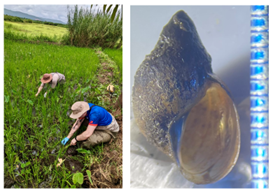
It’s not every day you find aliens in a rice paddy but when you do it becomes a noteworthy event as our article published in International Journal for Parasitology: Parasites and Wildlife shows.
In May 2023, whilst searching for intermediate snail hosts of schistosomiasis, an unusual little amphibious snail was first noted on the boundary between a rice paddy and a small pond. This snail had a dextral coiled shell, a body with triangular tentacles, with many other individuals found nearby on moist mud in between rice plants. To the untrained eye the shell could be easily explained away as an innocuous amber snail, however, its non-retractable tentacles pointed towards a species within the Lymnaeidae. The taxonomy within this snail family is notorious and requires careful inspection and assessment of both molecular and morphological characters.
In sub-Saharan Africa (SSA), there are only two species of lymnaeid, Radix natalensis and Galba truncatula, that are each considered ‘natural’, whereas a third species, Pseudosuccinea columella, is an ‘alien’ invasive. Arising from introduction(s) from North America, this latter species has been slowly colonising the continent. However, there is now a fourth species, Orientogalba viridis, an invasive alien snail originating from Asia. Importantly, upon first encounter of this snail population, a human schistosome, Schistosoma haematobium, was noted and suspected to have originated from these field-caught snails.

Quickly reacting to this parasitological alarm of putative schistosomiasis transmission, the HUGS team expanded their searches and conducted a set of infection challenge experiments. These results were carefully described to conclude that O. viridis is of special interest here in Malawi, and in SSA, for alien transmission potential of snail-borne disease. In March 2024, Sam Jones, Clinton Nkolokosa and Russ Stothard reinspected the original rice paddy and after screening 270 snails, were relieved to find no cercariae present.
Further vigilance should not stop here though, and when taken as a whole, the public health risk that this invasive snail species poses in Malawi should not be ignored. To conclude, do such alien snails exist elsewhere in SSA, are they playing unnoticed roles in disease transmission – most likely – only further studies with time will tell.